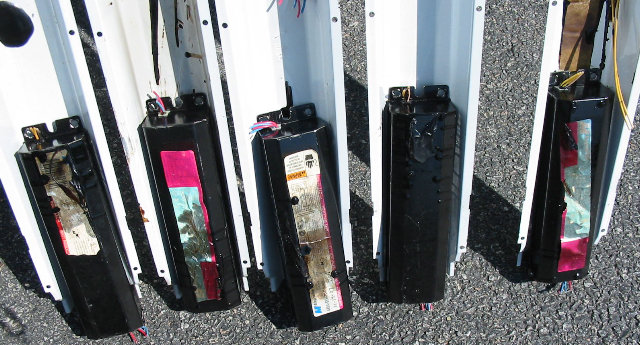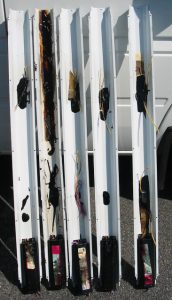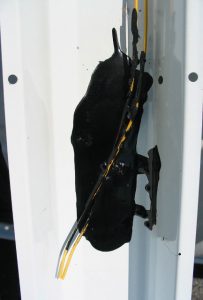
By Frank S. Johnson
 We all grew up with incandescent light bulbs. When they burned out, the light was gone, so we replaced them. No problem! Fluorescent lamps, on the other hand, are quite different. They actually need to be replaced before they quit working entirely, but no one seems to know it, and not many are teaching it.
We all grew up with incandescent light bulbs. When they burned out, the light was gone, so we replaced them. No problem! Fluorescent lamps, on the other hand, are quite different. They actually need to be replaced before they quit working entirely, but no one seems to know it, and not many are teaching it.
The fluorescent lamp was invented in the 1930’s, so the magnetic ballast has been around for quite a while. They are now rapidly being replaced by much lighter and more efficient electronic ballast. However, in the meantime, the nation is experiencing ballast fires daily, especially in the ceiling fixtures of older buildings. Old fluorescent fixtures, particularly the F96T12 (“8 footers”) mounted directly to wooden panel ceilings are prone to catching fire. But this is also happening in relatively new buildings, and with F40T12 (4 foot) lamps.
 So, what is happening, and how can it be prevented? Fluorescent technology is really very simple. First of all, the fluorescent lamp has to match the installed ballast. This means for example, that you should not install 40 watt lamps in a fixture running a ballast meant for 34 watt lamps. Secondly, the lamps actually have a “life expectancy”. The standard lamp manufactured today is designed to last approximately 3,000 hours. Based on use of 8 hours per day, 5 days a week, they are designed to perform for about 6 months. After this time, a burnout occurs, called cathode evaporation. This shows up as browning on the ends of the lamps. At this point, the visual lumens emitted by the lamp drop by 40% – 50%, so you only have a fraction of the light previously given. The lamp then needs to be changed or else it will begin to stress and eventually ruin the ballast. When you see a lamp that is black on the ends, it is well past its useful life. You may think you are saving money by not purchasing new lamps, but in reality, it will cost more money if they are left in place to ruin the ballast as well. Remember, bad lamps can ruin a good magnetic ballast, and a bad magnetic ballast can ruin good lamps.
So, what is happening, and how can it be prevented? Fluorescent technology is really very simple. First of all, the fluorescent lamp has to match the installed ballast. This means for example, that you should not install 40 watt lamps in a fixture running a ballast meant for 34 watt lamps. Secondly, the lamps actually have a “life expectancy”. The standard lamp manufactured today is designed to last approximately 3,000 hours. Based on use of 8 hours per day, 5 days a week, they are designed to perform for about 6 months. After this time, a burnout occurs, called cathode evaporation. This shows up as browning on the ends of the lamps. At this point, the visual lumens emitted by the lamp drop by 40% – 50%, so you only have a fraction of the light previously given. The lamp then needs to be changed or else it will begin to stress and eventually ruin the ballast. When you see a lamp that is black on the ends, it is well past its useful life. You may think you are saving money by not purchasing new lamps, but in reality, it will cost more money if they are left in place to ruin the ballast as well. Remember, bad lamps can ruin a good magnetic ballast, and a bad magnetic ballast can ruin good lamps.
This is what happens to the ballast when old lamps are left in place “trying to work”, whether the ballast is very old, or relatively new. After a stressed ballast has been trying to work for an hour or more, it gets extremely hot, the tar inside (loaded with PCB’s) becomes molten, shorts out the circuit, and the fixture no longer works. After a while, the ballast cools off enough for the molten tar to gel and the fixture starts to work again. It will at least try to work, but since the ballast is no longer balancing, the voltage remains in the “start mode”, or very high. This cycle repeats itself over and over until one of two things happen. Either the temperatures in the ceiling, aided by the heat build up in the attic finally reach the point that the ceiling bursts into flames, or the ballast itself will burst open in flames, spilling the molten, flaming tar down onto the floor. Then the building is on fire above and below. Many people across the nation have reported seeing this happen. The general public needs to be made aware that there is something wrong if a fixture is scalding hot. They should be equally aware, and now understand what is happening when their fluorescent lamps don’t come on, or else work awhile, then go out, then come back on. This should be a “red flag”!
When I perform a power audit involving linear fluorescent lamps, I use a ballast checker to determine whether it is magnetic or electronic. I then visually check to make sure the magnetic ballast is not overheating. If the ceiling is too high for a manual check, I use a thermal laser to measure the temperature of the ballast cover and the lamps as well. I then try to educate the owners about the hazards of ballast fire. In addition to suggesting a regular re-lamp program, we discuss changing the ballast, in segments if necessary, to electronic ballast. When used with electronic ballast, fluorescent lamps will simply go out, without damaging the lamps or causing a fire. After conducting some of theses “re-lampings” (I call it cleaning up “dirty power”), I have had people tell me that their power bill dropped as much as $200. This has even happened when I replaced 34 watt lamps with 40 watt lamps. I then realized how much it costs to keep inefficient ballast operating, and how much energy can be saved by keeping them running at their peak performance.
There is a safe alternative to changing out your lamps every 6 months. Although they are not widely promoted in our “throw away” society and they cost more initially, there are fluorescent lamps available that are designed to last longer, produce brighter light, and have higher lumen maintenance. This means that they will retain the same amount of light over the life of the lamp as they had when they were new. These “long life” fluorescent lamps are designed to perform 30,000 – 40,000 hours. Given the integrity of the ballast, the lamps could easily last 5 – 7 years, depending upon daily use. Though the initial investment in these lamps may be more, over their lifetime they will save money and the hassle of frequently changing out lamps, as well as prevent the chance of a fire.
Of course, the best choice today is electronic ballast. Everyone should be moving in this direction in their planning. If you choose to purchase “long life” lamps with low mercury, you will need ballast with a factor of .9 or above. I try to maintain a ballast factor of 1.15 for maximum performance and long life.
This article, along with related articles can be found HERE
